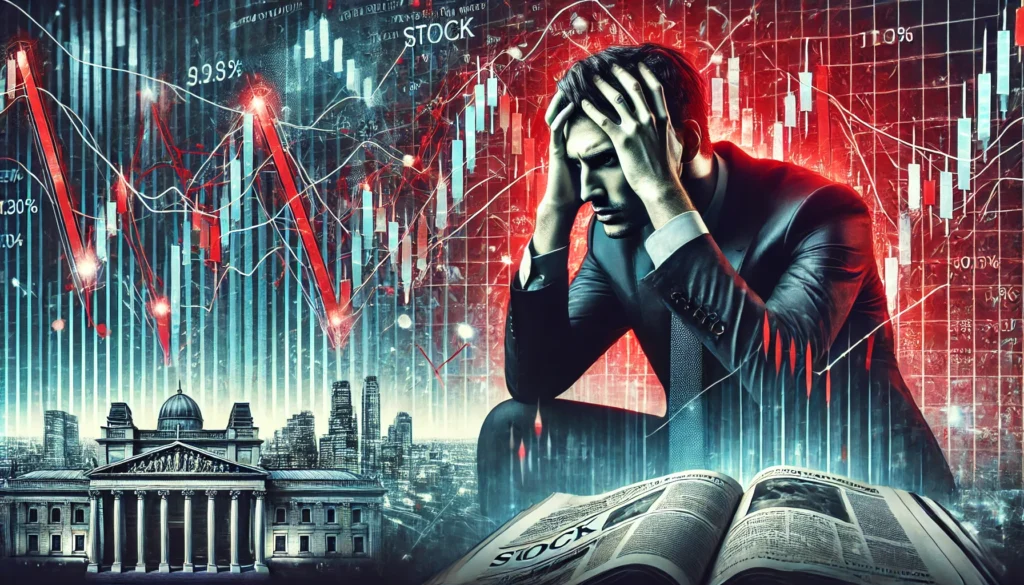
A visual representation of the stock market crash, highlighting financial losses, investor panic, and economic uncertainty.
The Stock Market Crash has sent shockwaves through India’s financial sector, with the BSE Sensex plunging 856 points and the Nifty50 losing 4% this month—marking the second-worst losing streak in the last 30 years. This sharp decline has raised concerns among investors and analysts alike. Here’s what’s driving the crash and what it means for the economy.
Key Reasons Behind the Stock Market Crash
1️⃣ Global Market Uncertainty 📉
- U.S. economic slowdown and weak global market trends have impacted investor sentiment worldwide.
- Trade tensions between major economies, including the U.S. and China, have led to significant market volatility.
- Rising interest rates in developed economies have reduced foreign investments in emerging markets like India.
(Source: The Economic Times)
2️⃣ Massive Foreign Investor Sell-Off 💰
- $25 billion has been pulled out of Indian equities by foreign institutional investors (FIIs) since the market peaked in September 2024.
- The withdrawal of foreign capital has led to a weakening rupee, making imports more expensive and affecting corporate profit margins.
- FIIs are reallocating funds to more stable markets, citing concerns about India’s economic growth and global market risks.
3️⃣ Sluggish Corporate Earnings 🏦
- Nifty 50 companies recorded only 5% earnings growth in the last quarter—continuing a streak of weak performance.
- Declining consumer spending, particularly in urban areas, is contributing to weak sales for key sectors like retail, automobiles, and banking.
- The IT sector, which plays a crucial role in India’s stock market, has seen a decline in overseas demand, impacting revenue forecasts.
(Source: Business Standard)
4️⃣ India’s Economic Growth Forecast Cut 📊
- India’s GDP growth projection has been slashed to 6.4%, the lowest in four years.
- Slower economic expansion raises concerns about long-term corporate growth and market recovery.
- Inflationary pressures, coupled with high borrowing costs, have made businesses hesitant to invest in expansion.
5️⃣ Interest Rate Pressures and Banking Sector Stress 🏦
- The Reserve Bank of India (RBI) has maintained high interest rates to control inflation, affecting borrowing costs for businesses and individuals.
- Higher loan costs have reduced demand in the housing and automobile sectors, impacting market growth.
- Concerns about bad loans in banking institutions have further weakened investor confidence in financial stocks.
How the Stock Market Crash is Reacting
📉 Stock Volatility: The Sensex and Nifty have seen large intraday fluctuations, signaling uncertainty among traders.
📊 Sectoral Impact: Banking, IT, and auto stocks have witnessed the biggest sell-offs, while defensive sectors like FMCG and pharmaceuticals have shown relative stability.
📈 Retail Investors: Many individual investors are staying on the sidelines, waiting for more clarity before making new investments.
Investor Sentiment and Future Outlook
🔹 Cautious Approach: Most analysts recommend a cautious approach, advising investors to focus on companies with strong fundamentals.
🔹 Long-Term Buying Opportunity? While the current crash is painful, some experts believe it presents a long-term buying opportunity for fundamentally sound stocks.
🔹 RBI’s Role: Market recovery could depend on the RBI’s stance on interest rates and how it responds to economic slowdown concerns.
What Should Investors Do Now?
1️⃣ Diversify Portfolio: Investors should avoid overexposure to a single sector and consider a mix of stocks, bonds, and alternative assets to manage risk.
2️⃣ Look for Defensive Stocks: Companies in healthcare, FMCG, and utilities tend to perform better during market downturns.
3️⃣ Monitor Global Trends: Since external factors are heavily influencing the market, keeping an eye on global developments is crucial.
4️⃣ Stay Patient: Volatility is an inherent part of investing. Long-term investors should avoid panic selling and focus on strong companies that can weather the downturn.

What’s Next?
Market analysts believe that investor sentiment will depend on global economic recovery, policy stability, and corporate earnings in the coming months. With heightened volatility, investors should stay informed and consider a balanced approach to managing risk.
The coming weeks will be crucial in determining whether this is a temporary correction or the beginning of a prolonged downturn. Regulatory measures, corporate performance, and global market trends will play a significant role in shaping market recovery. Investors and policymakers alike will be closely monitoring these developments.
Stay tuned for more updates on Suchak News as we track the market’s recovery and key financial trends.






